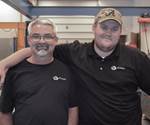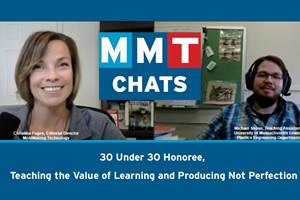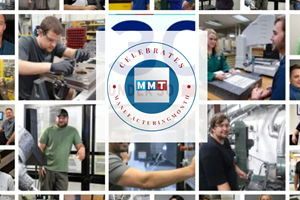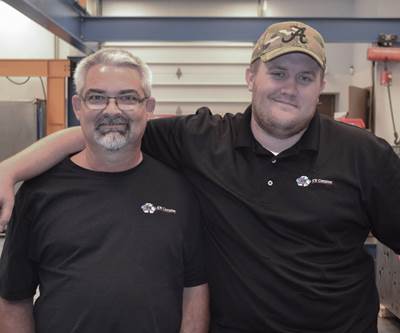Processing and Mold Repair Teams Collaborate to Solve Problems
Processing and mold repair technicians must work together as a team to solve mold problems quickly and correctly.
Share
Read Next
When a mold crashes or does not perform the way that a shop needs it to perform, fingers point in one of two directions. Those in the toolroom say, “Process can’t run it,” and those in processing say, “The toolroom can’t fix it.” After three decades of discussing mold performance with thousands of attendees at our training center, I continue to be amazed at the number of companies where this departmental clash still rages.
The demands of lean manufacturing practices are not going away as we continue to do what we can to get parts out the door. This entails building and running molds that start and perform reliably through a scheduled production run, whether that requires two hours, two months or longer. This will not happen consistently unless those in the toolroom and in processing work as a team. So why don’t they?
Getting to the Root Cause of the Rift
When the root cause of a problem is unknown, and shot-gunning fixes does not work, stressed-out technicians tend to take an emotional approach to pointing the blame in another direction. Workers in the toolroom and in processing draw lines and place blame without presenting supporting data. The battle continues to rage.
The complexity of molding plastic products, the daily struggle to efficiently produce quality parts on time and how little each department knows about the work done in the other departments all contribute significantly to the animosity that results. These issues, in combination with a fire-fighting maintenance culture (in which the aim is to fix it when it squeaks, leaks or breaks) and the enormous pressure that technicians endure to get the mold back up and running, make the perfect recipe for misunderstanding and confrontation.
Providing supporting data is the only way to avoid making corrective actions in the toolroom and on the molding floor that function as band-aids that do not address the root cause of an issue. A knee-jerk reaction is for a technician to just shove in new tooling or start turning knobs (tweaking) without any real justification, hoping something works long enough to get the mold through the required production run without stopping again.
A fire-fighting maintenance culture breeds “tooling replacers” and process “tweakers,” neither of which possess the necessary skills to perform accurate, critical analysis of processing or maintenance data. Fire-fighting molders use random journal entries in electronic work-order systems, maintenance logbooks or Excel spreadsheets. These contain subjective, non-standard language that tends to be inaccurate and extremely difficult to understand, which exacerbates issues and tempers.
The move away from firefighting is difficult because sometimes shoving a mold full of new tooling and randomly turning knobs at the press works. When a critical mold goes down, it is all hands-on deck to get it back up and running. Everyone does whatever it takes to make that happen, regardless of the merit or the risk of the corrective actions. Quickly fixing a dysfunctional mold puts pressure on the repair technician to replace a ton of tooling to ensure that the problem is not a mold issue. Similarly, the tweaker feels pressure to blindly start turning knobs at the press with no real knowledge of which process parameter will make the flash, non-fill or other defects go away. When any random tool change or tweak enables the shop to continue producing good parts again, everyone feels justified and happy. In these situations, however, the team has not identified the real issue or root cause of the problem.
Changing the Game Plan
Solving the real problem starts with acknowledging that the toolroom and molding floor are on the same team, despite having different roles. Many toolrooms view the molding department as a customer and not a teammate. Customers are not always told everything about how a mold performs during a production run (especially the bad things). There is an assumption that they do not need to know the specifics. In this guarded relationship, the value of transparent rapport is lost when troubleshooting and maintaining molds.
Applying ideas from individual silos of tooling and processing knowledge is not how a team functions. That would be like a coach telling a football team made up of individual skill players to just “go score points” without giving them a plan or data to reveal where best to attack the other team’s weakness. If the football players score, it is mostly luck.
For molds to run more reliably, the toolroom needs to work closely with processing to collect data and receive important feedback about the molds when they are in the press, creating a smarter maintenance plan that helps tooling and process technicians to discover root causes and make better decisions. In my experience, once trustworthy data is introduced into the troubleshooting process, real clues begin to emerge, calming emotions and eliminating issues.
Working as a Team
Process and repair technicians can better understand the needs of each department by holding weekly meetings to discuss appropriate data concerning mold stops and defects and to determine a hit list of high-frequency or high-cost issues.
It is not possible to focus on everything, so shops should make sure that they only spend as much time on an issue as it deserves. Most companies run 20 percent of their molds 80 percent of the time, so they should keep the list short and manageable. From this list, they should determine the bad actor molds and present the discoveries to the group to determine which metrics (frequency or costs) to use to indicate any progress. During these meetings, they should brainstorm ideas for corrective actions. It is important for shops to begin sharing mold performance knowledge and experiences as a group from the beginning. Teams should post the targets on a white board in the shop and keep it updated.
Not every issue will be resolved, but the right data will help teams better identify, understand and proactively attack each issue.
Not every issue will be resolved, but the right data will help teams better identify, understand and proactively attack each issue. Data will also allow better financial decision-making for the maintenance budget (true cost of running and maintaining the mold) and facilitate better customer relations with important and potential clients. Additionally, data will help designers and builders create better molds and improve product quality. When workers from processing and tooling work together, they can reduce problems.
About the Contributor
Steve Johnson
Steve Johnson is president of MoldTrax, which provides specialized course work, hands-on bench training, maintenance software, maintenance products, toolroom design and maintenance efficiency auditing.
Related Content
ICYMI, MMT Chats: 30 Under 30 Honoree, Plastics Engineering TA Teaches Value of Learning and Producing Not Perfection
MoldMaking Technology Editorial Director Christina Fuges brings on UMass Lowell Plastics Engineering Teaching Assistant Michael Shone as a guest for this MMT Chat to discuss moldmaking through the lens of academia. This episode is brought to you by ISCAR with New Ideas for Machining Intelligently.
Read MoreHow to Improve Your Current Efficiency Rate
An alternative approach to taking on more EDM-intensive work when technology and personnel investment is not an option.
Read MoreExploring ISO 9000 - Part 16 Control of Quality Records
A Series of International Standards for Quality Management and Quality Assurance. We begin 2022 with a review of Clause 4.16 Control of Quality Records.
Read More30 Under 30: The New Face of Moldmaking
Young professionals are vital to the moldmaking industry, and it is important to acknowledge those making strides in shaping the industry's future. MoldMaking Technology recognizes the industry's young talent through its inaugural 30-Under-30 Honors Program.
Read MoreRead Next
Maintenance Matters: The Right Personalities are Key to Reducing Workplace Breakdowns
Building an efficient, successful team with the right attributes reduces the incidents of mold breakdowns.
Read MoreHow to Use Strategic Planning Tools, Data to Manage the Human Side of Business
Q&A with Marion Wells, MMT EAB member and founder of Human Asset Management.
Read MoreAre You a Moldmaker Considering 3D Printing? Consider the 3D Printing Workshop at NPE2024
Presentations will cover 3D printing for mold tooling, material innovation, product development, bridge production and full-scale, high-volume additive manufacturing.
Read More_970x90 4.png;maxWidth=970;quality=90)













.jpg;maxWidth=300;quality=90)
_300x250 3.png;maxWidth=300;quality=90)












